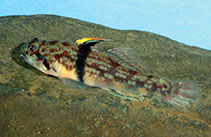| Family: |
Gobiidae (Gobies), subfamily: Gobionellinae |
| Max. size: |
3.8 cm SL (male/unsexed) |
| Environment: |
benthopelagic; freshwater; brackish; marine; dH range: 8; depth range 0 - 5 m, amphidromous |
| Distribution: |
Asia: Sri Lanka, Philippines, Malaysia and Indonesia (Ref. 13235); Japan (Ref.43239). Oceania: New Guinea. Reported from New Caledonia (Ref. 13235), Micronesia (Ref. 59012). Africa: Mozambique. Indian Ocean: Madagascar, Mayotte (Ref. 55749). |
| Diagnosis: |
Dorsal spines (total): 7-7; Dorsal soft rays (total): 6-7; Anal spines: 1-1; Anal soft rays: 6-6. Distinguished by the following characteristics: moderate-sized Redigobius; single black band extending down and back from tip of first dorsal fin; distinct black band extending from eye diagonally across opercle to lower edge of pectoral fin base; first dorsal fin tall and elongate, third or fourth spine longest; opercle with small ctenoid scales; 14 circumpeduncular scales; second dorsal rays modally I,7; anal rays I,6; pectoral rays 16-17; longitudinal scales 23-25; TRB 9-11; predorsal scales 9-12 (Ref. 84480). |
| Biology: |
Adults inhabit coastal estuaries, lakes (Ref. 48637), and entering lower reaches of freshwater streams (Ref. 44894). Also found in quiet mangrove estuarine habitats (Ref. 84480). Also Ref. 43716. |
| IUCN Red List Status: |
Least Concern (LC); Date assessed: 12 August 2019 Ref. (130435)
|
| Threat to humans: |
harmless |
Source and more info: www.fishbase.org. For personal, classroom, and other internal use only. Not for publication.
